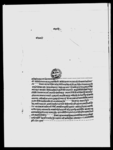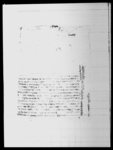A rukkā of King Rājendra to the janarala khajāñci effecting administrative changes in the bookkeeping of the Kausī Tosākhānā (VS 1902)
ID: DNA_0011_0035
Edited and
translated by Simon Cubelic
in collaboration with
Rajan Khatiwoda, Ramhari Timalsina
Created: 2015-02-02;
Last modified: 2017-07-04
For the metadata of the document, click here
The accompanying edition, translation/synopsis and/or commentary are available under the terms of the Creative Commons Attribution-ShareAlike 4.0 International License
Abstract
In response to a large number of unupdated accounts, King Rājendra in this rukkā instructs the janarala khajāñci of the Kausī Tosākhānā to implement changes in the institution’s administrative procedures: first, the mukhiyā of the Kausī is to prepare its ledger (śrestā) himself; second, two clerks (nausindās) are to be assigned to the Tosākhānā for bookkeeping purposes; third, cost overruns reimbursed through deductions from the salaries of the officials responsible for them are to be accurately recorded.Diplomatic edition
[1r]
श्रीदुर्गाज्यू\श्रीकुमारि[royal seal]1स्वस्तिश्रीमन्महाराजाधिराजकस्यरुक्का¯ ¯ ¯ ¯ ¯ ¯ ¯ ¯ ¯¯ ¯ ¯ ¯ ¯ ¯ ¯ ¯ ¯ ¯ ¯ ¯ ¯ ¯2आगे•कौसितोसाषानाकाजनरलषजांचिप्रतिकौसितोसाषानामाहाम्रादर्वारकोआमदानीषर्चलेषना
3लाइ¯ ¯ ¯ ¯चोकवाटआयाकानौसिन्दावाहेक्कौसिकामुषियापट्टिकोएकनौसिन्दातोसाषानामाराषि
4आफुलेकौसिमावसि•लेषपढभैआयामालेषपढवढनजादा•ढेरैवर्षकोकागजपत्ररुजुवाजुनभैचिट्ठा
5तयारनहुदाअवउप्रान्त•कौसिकामुषियालेएकनौसिंदासाथमालिआफुलेकौसिकोश्रेस्तालेषनु•दु
6इनौसिंदातोसाषानामाराषीएकजनालेश्रेस्तालेषाउनुएकजनालेकौसिमालेषियाकोआमदानीष
7र्चतोसाषानाकाथागनामासारिरुजुवाजुगरिनचढ्याकोचढाउनु•अघिपछितिर्जापुर्जागैह्रपरिआयाको
8कामपुर्याइ•अघिअघिकाथागनारुजुवाजुगरितयारगर्नुऔआजसम्मचलीआयावमोजिम्रकमदार
9हरूसँगकौसिमाव़ासिलवाँकिगरिज्माषर्चफारकलिन¯ ¯ ¯ ¯चोकपठाउनुरकम्दारगैह्रले¯ ¯ ¯ ¯
10चोक्मावहिपत्रवुझाउँदाज्माषर्चमाफाजिलठहर्याको•कौसिमार्फत्कतैरकम्मातनुषाहलेभर्नागरि
11दिदा•आजसम्मज्माषर्चमाभर्नानलेषीज्माषर्चमाफाजीलैरहनजादा•कारिंदाहरूफेरफारभयापछि
12फाजिलतनुषाहभयानभयाकोज्माषर्चमाहेरिथाहानभैसंदेहरहनजांछभन्नानिमित्तअवउप्रांत्त•जस्
13काज्माषर्चकोफाजीलजहातनुषाहहुंछफलानामितिमाफलानाठाउमायेतिरूपैयातनुषाहलेभर्ना
14भनिज्माषर्चमालेषिदिनु¯ ¯ ¯ ¯चोकमारह्याकाज्माषर्चकोनकलमापनिलेषनलगाउनुभंन्यावंदे
15जवाधिवक्स्यौं•येस्वन्देजमाजोरह्वैनतसलाइभारिसजायेहोला•इतिसम्वत्१९०२सालमितिपौष
16सुदि४रोज५शुभम्¯ ¯ ¯ ¯ ¯ ¯ ¯ ¯ ¯ ¯ ¯ ¯ ¯ ¯ ¯ ¯ ¯ ¯ ¯ ¯ ¯ ¯ ¯ ¯ ¯ ¯ ¯ ¯ ¯ ¯
[1v]
1रुजुकुलमानसिंहवस्न्यात्रुजुजंङ्वाहादुरकव़ररुजुफत्त्यजङ्गसाह2रुजुगगनसिंह
3रुजुदलभञ्जनपाँडेरुजुसुरथ्सिंपंत
Translation
[1r]
Venerable Durgājyū
Venerable Kumārī
[royal seal]
Hail! [This is] a missive (rukkā) of the venerable supreme king of the great kings.
To the Janarala Khajāñci1 of the Kausī Tosākhānā.
In order to keep the records of the income and expenditures of our palace (darabāra) in the Kausī Tosākhānā, besides the clerk (nausindā) who came from the coka [of] the Venerable Kumārī (Kumārīcoka) a clerk from the Kausīmukhiyā’s side was placed at [the disposal of] the Tosākhāna, and they have been carrying out the bookkeeping, sitting [together] at the Kausī. Since the amount of bookkeeping (lekhapaḍha) has increased, many years’ worth of documents have not been rechecked for accuracy (rujuvāju) and balance sheets (ciṭṭhā) have not been prepared, from now on the mukhiyā of the Kausī should take a clerk with him [as an assistant] and himself keep the ledger (śrestā) of the Kausī.
Two clerks (nausindā) should be placed at the Tosākhānā. One should be made to keep the ledger. The other one should copy the income and expenditures recorded at the Kausī into the thāganā2 of the Tosākhānā, recheck it for accuracy and enter [items] that have not been entered yet. Complete prior and pending tasks of [issuing] tirjās, purjās and so forth and recheck for accuracy and make earlier thāganās ready [for review]. And, as has been practised up to this day, once the vāsila-bā̃kis have been prepared in collaboration with the rakamadāras at the Kausī, [they] should be sent to the coka [of] the Venerable Kumārī in order to obtain phārakas for the total expenditures (jamā kharca).
When the rakamadāras and so forth submit the ledger to the coka [of] the Venerable Kumārī, and whenever an overrun (phajila) on total expenditures is determined, [the overrun] on the [individual] account (rakama) is reimbursed through the Kausī by deducting it from a salary somewhere. Since such reimbursements have not been recorded for total expenditures up till now, overruns [may] still remain on total expenditures. When clerks are reshuffled, it cannot be known by looking at the total expenditures whether [individual] overruns have been [reimbursed] or not [from] salaries, so that doubt remains. Therefore, we have put into effect a rule that from now on, whenever someone's overrun on total expenditures is to be reimbursed through his salary, the reimbursement through his salary, [together with] the date, place and number of rupees should be recorded under the total expenditures. The [same] documentation should also be recorded in the copies of total expenditures which remain [on file] at the coka [of] the Venerable Kumārī. Whoever does not obey this rule will be subject to heavy punishment.
Wednesday, 4th of the bright fortnight of Pauṣa in the [Vikrama] era year 1902 (1846 CE). Auspiciousness.
[1v]
Attested by Kulamānasiṃha Basnyāt, attested by Jaṅgabāhādura Kũvara, attested by Phattyajaṅga Śāha.
Attested by Gagana Siṃha.
Attested by Dalabhañjana Pā̃ḍe, attested by Surath Siṃ Panta.


